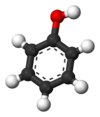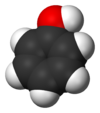Phenol
 From Nwe
From Nwe | Phenol | |
|---|---|
 |
|
| Systematic name | Phenol |
| Other names | Carbolic Acid Benzenol Phenylic Acid Hydroxybenzene Phenic acid |
| Chemical formula | C6H5OH |
| SMILES | Oc1ccccc1 |
| Molar mass | 94.11 g/mol |
| Appearance | White Crystalline Solid |
| CAS number | [108-95-2] |
| Properties | |
| Density | 1.07 g/cm3 |
| Solubility in water | 8.3 g/100 ml (20 °C) |
| Melting point | 40.5 °C |
| Boiling point | 181.7 °C |
| Acidity (pKa) | 9.95 |
| Structure | |
| Molecular shape | planar |
| Dipole moment | ? D |
| Hazards | |
| MSDS | External MSDS |
| EU classification | Toxic (T) Muta. Cat. 3 Corrosive (C) |
| NFPA 704 | |
| R-phrases | R23/24/25, R34, R48/23/24/25, R68 |
| S-phrases | S1/2, S24/25, S26, S28, S36/37/39, S45 |
| Flash point | 79 °C |
| Autoignition temperature | 715 °C |
| RTECS number | SJ3325000 |
| Supplementary data page | |
| Structure and properties |
n, εr, etc. |
| Thermodynamic data |
Phase behaviour Solid, liquid, gas |
| Spectral data | UV, IR, NMR, MS |
| Related compounds | |
| Related compounds | Benzenethiol |
| Disclaimer and references | |
Phenol, also known under an older name of carbolic acid, is a toxic, colorless crystalline solid with a distinctive sweet tarry odor. Its chemical formula is C6H5OH and its structure is that of a hydroxyl group (-OH) bonded to a phenyl ring; it is thus an aromatic compound.
Phenols
The word phenol is also used to refer to any compound which contains a six-membered aromatic ring, bonded directly to a hydroxyl group (-OH). In effect, phenols are a class of organic compounds of which the phenol discussed in this article is the simplest member.
Properties
Phenol has a limited solubility in water (8.3 g/100 ml). It is slightly acidic: the phenol molecule has weak tendencies to lose the H+ ion from the hydroxyl group, resulting in the highly water-soluble phenoxide anion C6H5O−. Compared to aliphatic alcohols, phenol shows much higher acidity; it even reacts with NaOH to lose H+ whereas aliphatic alcohols do not. Contrary to popular belief, this has little to do with orbital overlap between the oxygen's lone pairs and the aromatic system.
While the aromaticity of the benzene ring allows delocalization of the negative charge throughout the ring to stabilize the anion, the dominant effect is the induction from the sp2 hybridized carbons (the comparatively more powerful inductive withdrawal of electron density that is provided by the sp2 system compared to an sp3 system allows for great stabilization of the oxyanion). In making this conclusion, we cite the pKa of acetone enol, which is 10.9 (in comparison to phenol with a pKa of 10.0).
Production
Phenol can be made from the partial oxidation of benzene or benzoic acid, by the cumene process, or by the Raschig process. It can also be found as a product of coal oxidation.
Uses
Phenol has antiseptic properties and was used by Sir Joseph Lister (1827-1912) in his pioneering technique of antiseptic surgery, though the skin irritation caused by continual exposure to phenol eventually led to the substitution of aseptic (germ-free) techniques in surgery. It is also the active ingredient in some oral anesthetics such as Chloraseptic spray. Phenol was also the main ingredient of the Carbolic Smoke Ball, a device sold in London designed to protect the user against influenza and other ailments.
It is also used in the production of drugs (it is the starting material in the industrial production of aspirin), weedkiller, and synthetic resins (Bakelite, one of the first synthetic resins to be manufactured, is a polymer of phenol with formaldehyde). Exposure of the skin to concentrated phenol solutions causes chemical burns which may be severe; in laboratories where it is used, it is usually recommended that polyethylene glycol solution is kept available for washing off splashes. Washing with large amounts of plain water (most labs have a safety shower or eye-wash) and removal of contaminated clothing are required, and immediate ER treatment for large splashes; particularly if the phenol is mixed with chloroform (a commonly used mixture in molecular biology for DNA purification). Notwithstanding the effects of concentrated solutions, it is also used in cosmetic surgery as an exfoliant, to remove layers of dead skin. It is also used in phenolization, a surgical procedure used to treat an ingrown nail, in which it is applied to the toe to prevent regrowth of nails.
Misuse by the Nazis
Injections of phenol have occasionally been used as a means of rapid execution. In particular, phenol was used as a means of extermination by the Nazis during the Second World War. Phenol injections were given to thousands of people in concentration camps, especially at Auschwitz-Birkenau. Injections were administered either by medical doctors or by their assistants; such injections were originally given intravenously, more commonly in the arm, but injection directly into the heart, so as to induce nearly instant death, was later preferred. One of the most famous inmates at Auschwitz to be murdered by carbolic acid injection was St. Maximilian Kolbe, a Catholic priest who volunteered to undergo three weeks of starvation and dehydration in the place of another inmate and who was finally injected with carbolic acid so that the Nazis could make more room in their holding cells.[1]
See also
Notes
- ↑ Auschwitz - Final Station Extermination: Killing Through Phenol Injection Johannes Kepler University, Linz, Austria. Retrieved November 28, 2007.
References
ISBN links support NWE through referral fees
- McMurry, John. 2004. Organic Chemistry. 6th ed. Belmont, CA: Brooks/Cole. ISBN 0534420052
- Morrison, Robert T., and Robert N. Boyd. 1992. Organic Chemistry. 6th ed. Englewood Cliffs, NJ: Prentice Hall. ISBN 0-13-643669-2
- Solomons, T.W. Graham, and Craig B. Fryhle. 2004. Organic Chemistry. 8th ed. Hoboken, NJ: John Wiley. ISBN 0471417998
External links
All links retrieved November 23, 2022.
Credits
New World Encyclopedia writers and editors rewrote and completed the Wikipedia article in accordance with New World Encyclopedia standards. This article abides by terms of the Creative Commons CC-by-sa 3.0 License (CC-by-sa), which may be used and disseminated with proper attribution. Credit is due under the terms of this license that can reference both the New World Encyclopedia contributors and the selfless volunteer contributors of the Wikimedia Foundation. To cite this article click here for a list of acceptable citing formats.The history of earlier contributions by wikipedians is accessible to researchers here:
The history of this article since it was imported to New World Encyclopedia:
Note: Some restrictions may apply to use of individual images which are separately licensed.
↧ Download as ZWI file | Last modified: 02/03/2023 22:21:05 | 14 views
☰ Source: https://www.newworldencyclopedia.org/entry/Phenol | License: CC BY-SA 3.0
 ZWI signed:
ZWI signed:



 KSF
KSF